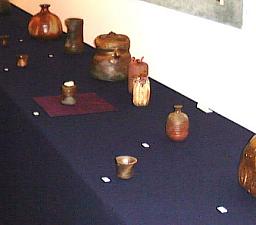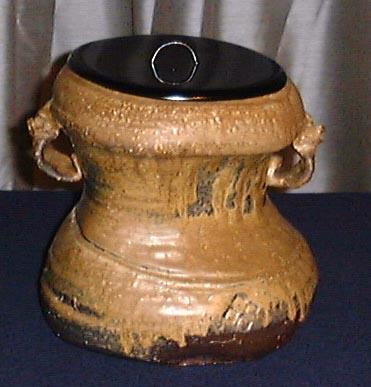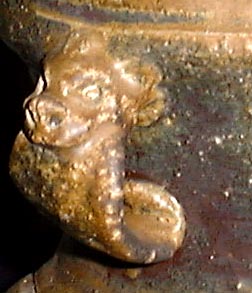|

LEARN MORE
Interview with
Abe Anjin
Bottoms-Up
Firing

Yellin's gallery
sells pieces from
the kilns of Japan's
finest potters
|
|
Abe Anjin Exhibition Review
Sankeido Gallery, Tokyo, July 23 to 29, 2001
 |
Most lovers of Bizen pottery know that the glory days of this medieval ware spanned the late Muromachi, all of Momoyama, and early Edo periods. It wasn't until the 1930s that Kaneshige Toyo revived the lost ancient ways and cast the 'Momoyama spell' over the twentieth century and up to where we are today. I'd say at least ninety percent of all current Bizen potters make pots in the same shapes that were first made during Bizen's golden years, those being in the Momoyama period.
It would be like every Italian sculptor trying to re-create Michelangelo's David, most not even coming close. Bizen is said to be in its second golden period that began in the 1950s and continues to this day. Yet even though many Bizen potters have prospered it doesn't mean they make golden pieces.
More than that, Japan had a population with money to spend and a habit to buy 'brand names.' Most of it is very uninspired, soulless work.
In the current Bizen scene, there are three potters who stand out in their excellence in instilling the Momoyama spirit and technique in their creations. All three have researched kilns, clay, and processes for many years and all are in their sixties. Their Bizen is quite classical and often very exhilarating; they are Harada Shuroku, Mori Togaku, and Abe Anjin.
Abe recently had an exhibition in Tokyo and it was a joy to see his work again. Although I was a bit confused on why he was having an exhibition in mid-summer, Bizen is so much for the fall! And it was terribly hot the day I visited; those poor salarymen in Tokyo being suffocated in their blue suits and stiff ties?.
The gallery, Sankeido, has been around since 1871 and is well-known in the fine arts world in Japan. It wasn't much of a space though, just a small room. But I can imagine it was quite beautiful before Tokyo was burnt to the ground in WWll.
When looking at Abe's work I have the feeling that it was reincarnated from a Momoyama piece, it's startling to see what an alchemist he is. At a tea ceremony once a well-know collector spoke of the stunning Momoyama mizusashi that the host was using. It turned out to be an Abe piece.
His mizusashi are very much more of a sculpture than a tea utensil. It's only when the mizusashi is matched with other tea utensils that it becomes a mizusashi. Left alone it is a clay sculpture. In the exhibition Abe had a few mizusashi. One had two lion ears and a rich coating of natural goma (sesame seed paste) glaze cascading down the inwardly pinched form. It had a small stamp impressed near the base and a line etched around the body looking like a low-slung belt.
 |
 |
Another one was a sumo yokozuna grand champion with its stout form and heavy shoulders (below).
Abe believes the position of the ears is essential for the balance of a piece and one can see how they perfectly balance the form here. I also particularly liked the top and the lid for the rich tsuchi aji clay flavor and goma; a slight kiln crack adds to the earthiness of the piece.
A rare type of goma is called shiro-goma or white goma and was originally found on Muromachi period pieces. One Abe vase was ghost-like in the appearance of the white goma. It appeared as if the ghost was doing zen meditation on the traveler's pillow-shaped vase.
Abe also excels in his works with hidasuki or the scarlet red fire cord markings. All the hidasuki pieces, and as a matter of fact all of Abe's Bizen, are fired in saggers. This is quite unusual, as most Bizen potters don't fire this way. Abe's hidasuki is incandescent, streaking across large turnip shaped kabura forms, smaller mizusashi, and round-shouldered tokkuri.
I've been to his kiln and saw all the broken hidasuki shards, the failure rate is quite high but the triumphs make up for the sweat and tears.
Abe started out as a painter years ago and switched to pottery after a serious illness. He still works with paints though and displayed some mixed media works consisting of oil paint, lacquer, washi-Japanese paper, and cardboard boxes.
He also works in bronze casting and here he is standing in front of one.
A very talented artist, and one that has been a secret known only to connoisseurs. For more on Abe:
-- Abe Anjin Review
-- Sake Vessels - A Wonderful Trio
-- Interview with Abe Anjin
|